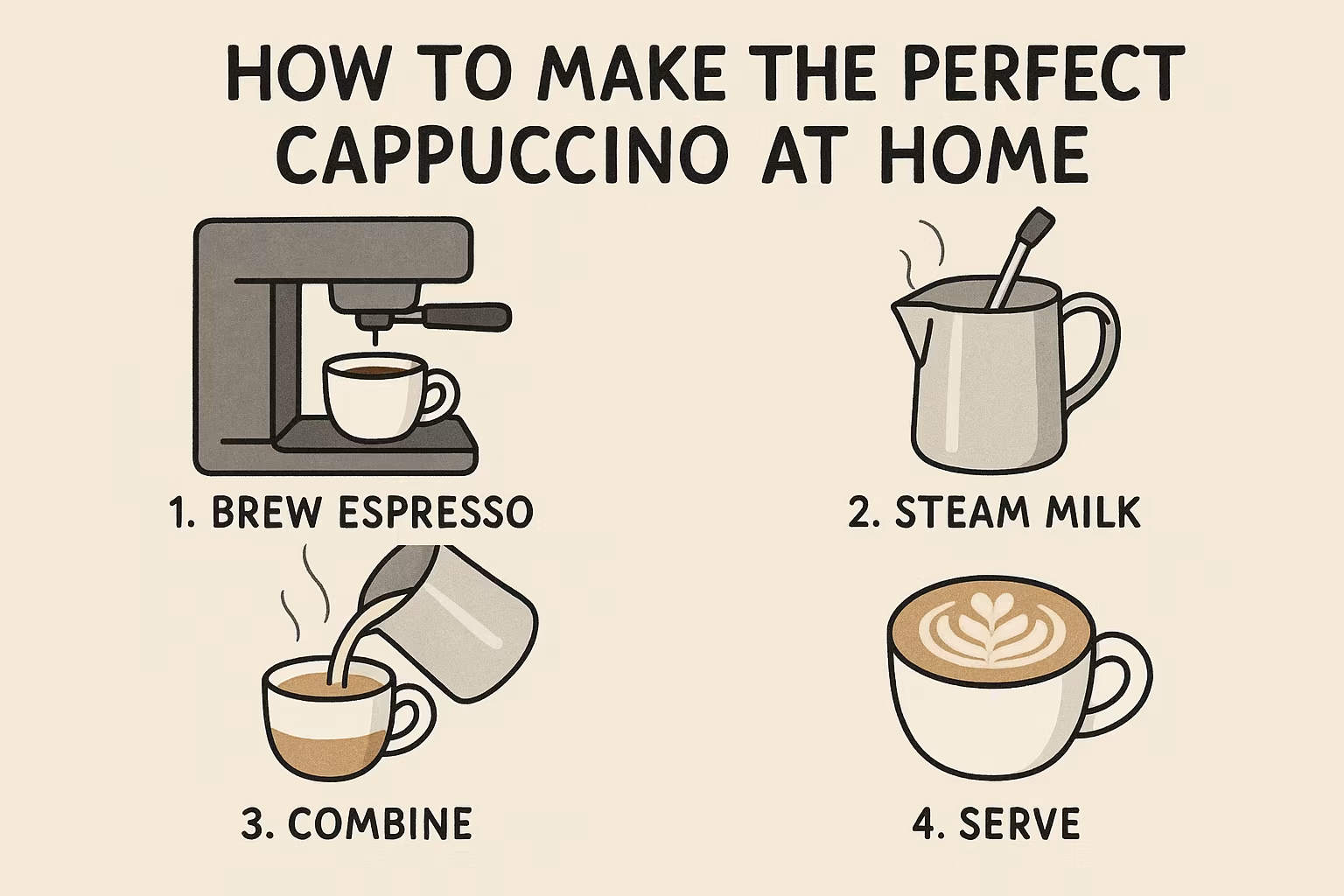Discover how to make the perfect cappuccino at home with simple steps, expert tips, and the right tools. Learn about milk frothing, coffee ratios, and common mistakes to avoid so you can enjoy barista-quality cappuccinos in your kitchen.
How to Make the Perfect Cappuccino at Home: Easy Guide
There’s something magical about holding a warm cappuccino in your hands—velvety milk foam resting on top of a bold espresso, a balance of bitterness and creaminess that makes every sip delightful. For many coffee lovers, the question is not whether to drink cappuccino but how to make the perfect cappuccino at home.
Step-by-Step Guide: How to Make the Perfect Cappuccino at Home
The heart of this guide lies in answering what readers most want: the practical steps of preparing an authentic cappuccino in their own kitchen. According to the Italian Espresso National Institute, a cappuccino should consist of one-third espresso, one-third hot milk, and one-third milk foam. This golden ratio is the foundation of every great cup.
“Coffee should be black as hell, strong as death, and sweet as love.” — Turkish Proverb. While cappuccino might not be sweet by default, it carries the same passion and philosophy behind every great cup of coffee.
Let’s dive into the process step by step.
Choosing the Right Coffee Beans for Cappuccino
The journey begins with coffee beans. Without the right beans, even the best milk frother cannot save your cappuccino. Ideally, use medium to dark roast beans with a rich aroma. Lighter roasts often taste too acidic for cappuccino, while darker roasts provide the chocolatey, nutty notes that balance milk beautifully.
Arabica vs Robusta: Arabica beans are smoother and slightly acidic, while Robusta beans bring more caffeine and bitterness. A blend of both is often recommended.
Freshness matters: Always grind your beans fresh. Pre-ground coffee loses aroma within days. Invest in a burr grinder for consistent results.
Origin influence: Brazilian beans often offer chocolate notes, Ethiopian beans add floral tones, and Vietnamese Robusta adds body and caffeine.
Pro tip: Many baristas, including those from Italian cafés in Milan and Rome, stress the importance of freshly roasted beans no older than 4 weeks for the best crema.
See more: 10 Best Pour Over Coffee Makers for Perfect Brews
The Ideal Espresso-to-Milk Ratio
A cappuccino is not just coffee with milk—it is harmony in a cup. The traditional espresso-to-milk ratio ensures balance:
| Component | Amount | Role in Taste |
|---|---|---|
| Espresso | 30 ml (1 shot) | Strong, bold base |
| Steamed Milk | 30 ml | Softens intensity |
| Milk Foam | 30 ml | Adds texture and aroma |
Too much milk? You’ll end up with a latte. Too little foam? You lose the signature cappuccino texture.
Tip: Use a demitasse or 150 ml cup—this is the standard size in Italy, ensuring the ratio stays intact.
Frothing Milk Like a Barista
Milk frothing is the soul of cappuccino. A perfect cappuccino has microfoam: silky, velvety milk with no large bubbles.
Steps to Froth Milk Properly:
Choose the right milk: Whole milk produces the creamiest foam thanks to higher fat content. Oat milk and soy milk can also work, but results vary.
Cold start: Always use cold milk straight from the fridge. Fill the pitcher no more than one-third full.
Position the steam wand: Keep the tip just below the surface for a few seconds to stretch the milk, then immerse deeper to heat it.
Temperature control: Stop frothing at 65–70°C (150–160°F). Overheating will scorch milk and ruin texture.
“Good milk frothing is like music—you don’t notice it unless it’s wrong.” — a saying often shared in barista training schools in Florence.
Visual cue: The milk should resemble wet paint, glossy and smooth, not bubbly or stiff.
Assembling Your Cappuccino: Pouring & Layering
Now comes the artistry. A cappuccino isn’t simply about mixing coffee and milk—it’s about layering.
Pull a fresh espresso shot into your cup.
Swirl the milk jug gently to integrate foam and liquid milk.
Begin pouring slowly into the center of the espresso.
Tilt the cup slightly and raise the pitcher for a steady stream.
Finish with a final push of foam to crown your cappuccino.
This is also where latte art begins. Even a simple heart shape can elevate your homemade cappuccino to café level.
Must-Have Tools & Equipment for Homemade Cappuccino
While it’s possible to make a cappuccino without professional gear, having the right tools dramatically improves your consistency.
Espresso Machines vs Manual Brewing
Espresso Machine: Delivers authentic results. Brands like Breville, De’Longhi, or Gaggia are popular choices.
Moka Pot: A stovetop option that produces strong coffee, though technically not espresso, still works for cappuccino.
AeroPress + Espresso Filter: A budget-friendly method for beginners.
Comparison Table:
| Tool | Pros | Cons |
|---|---|---|
| Espresso Machine | Authentic, consistent crema | Expensive |
| Moka Pot | Affordable, traditional in Italy | No crema, less pressure |
| AeroPress | Portable, versatile | Not true espresso |
Milk Frothers: Electric vs Handheld
Electric Frothers: Easy to use, heat and froth simultaneously.
Handheld Frothers: Affordable and portable, but require separate heating.
Steam Wand (machine built-in): Best professional result but requires practice.
Other Helpful Accessories
Burr Grinder: Ensures even grind size.
Thermometer: Prevents overheating milk.
Stainless Steel Pitcher: Essential for milk frothing and latte art.
Digital Scale: Keeps espresso ratios consistent.
Pro Tips for Perfect Cappuccino Every Time
Now that you know the steps and tools, let’s talk about refinement. Baristas spend years perfecting cappuccino, but with these tips, you’ll drastically improve your results at home.
Achieving Creamy, Velvety Foam
Use fresh, cold milk and don’t rush the frothing process. Baristas recommend swirling the pitcher in small circles to integrate foam and liquid.
Balancing Temperature and Texture
The ideal serving temperature of a cappuccino is 65°C (150°F). Hotter than this, the milk proteins break down, causing a burnt taste. Cooler than this, the drink feels lukewarm and flat.
Latte Art Basics for Beginners
Latte art isn’t just about aesthetics—it reflects well-textured milk. Start with a heart shape:
Hold the cup at a 45° angle.
Pour milk into the center slowly.
As the cup fills, move the pitcher closer to the surface.
Finish with a quick pull through to form the heart.
Even if your art doesn’t work, your cappuccino will still taste divine.
Cappuccino vs Latte: What’s the Difference?
A common confusion for coffee beginners is the difference between cappuccino and latte.
| Feature | Cappuccino | Latte |
|---|---|---|
| Coffee-to-Milk Ratio | 1:1:1 | 1:3 |
| Foam | Thick, airy | Thin, silky |
| Flavor | Strong, balanced | Creamier, milder |
| Cup Size | 150 ml | 240 ml |
In short: a cappuccino emphasizes balance, while a latte emphasizes milk.
Common Mistakes to Avoid When Making Cappuccino
Even experienced home brewers make errors that compromise the quality of their cappuccino. Avoiding these common pitfalls ensures your cup tastes just as it would in a professional café.
Using the Wrong Coffee Beans
Not all beans are created equal. If you use beans roasted for filter coffee instead of espresso, your cappuccino will taste thin and unbalanced. Specialty cafés like Lyoncafe emphasize sourcing beans specifically roasted for espresso to achieve depth and richness. Remember, espresso requires finely ground, dense beans that extract slowly under high pressure.
Overheating the Milk
Milk should never exceed 70°C (160°F). Once overheated, proteins break down and the foam becomes dry. Instead of the creamy microfoam you expect, you’ll get stiff bubbles that collapse quickly. A thermometer is an inexpensive but powerful investment to prevent this mistake.
Incorrect Coffee-to-Milk Ratio
The hallmark of cappuccino is its balance. Too much milk and it becomes a latte; too little milk and the bitterness of espresso overwhelms. Stick to the 1:1:1 ratio—a rule followed religiously in Italian cafés. At Lyoncafe (mtnlyoncafe.com), our training team often demonstrates how simply adjusting ratios transforms the taste dramatically.
Enhancing Your Cappuccino Experience at Home
A cappuccino is more than just a drink—it’s a ritual. Enhancing this ritual at home creates a café atmosphere without leaving your kitchen.
Adding Flavored Syrups or Spices
Cappuccinos are versatile canvases. While traditionalists may prefer the classic form, adding a touch of flavor can elevate the experience. Popular additions include:
Vanilla syrup for sweetness
Cinnamon powder for warmth
Nutmeg for a festive touch
Chocolate shavings for indulgence
As the Italian saying goes, “La vita è troppo breve per bere caffè cattivo” (Life is too short to drink bad coffee). Customize your cappuccino to your mood and the moment.
Pairing Cappuccino with Food
The cappuccino is traditionally consumed at breakfast in Italy, often paired with a croissant or biscotti. But pairing ideas extend further:
Morning energy: Cappuccino with buttered toast or fruit.
Afternoon break: Cappuccino with dark chocolate or almond cookies.
Evening delight: Cappuccino alongside tiramisu or panna cotta.
Studies on consumer behavior in Milan cafés show that food pairings increase the perceived quality of coffee experiences by 35%. Bringing this practice home can add sophistication to your coffee time.
The Cultural Dimension of Cappuccino
The cappuccino carries centuries of history. Originating in 17th-century Vienna, named after Capuchin monks (their robes resembled the coffee’s color), it became an Italian staple and later spread worldwide. Today, it remains a symbol of leisure, culture, and refinement.
Vienna, Austria (1600s): Early milk-and-coffee drinks appear.
Italy (1900s): Espresso machines revolutionize cappuccino.
Global (2000s): Specialty cafés and home brewing expand access.
At Lyoncafe, located in Silverthorne, Colorado, we blend this rich heritage with modern practice. Our baristas are trained not only in technique but also in storytelling—because every cappuccino carries a story. Learn more at mtnlyoncafe.com.
Evidence-Based Tips Backed by Barista Experience
A recent survey by the Specialty Coffee Association (SCA) revealed that 70% of consumers judge the quality of a cappuccino by its foam texture. Another study by the Coffee Science Foundation highlights that using freshly ground beans improves flavor extraction by up to 40% compared to pre-ground coffee.
At Lyoncafe, our motto is simple: “Every cup tells a story.” We’ve tested hundreds of brewing methods, frothing styles, and bean origins to deliver consistent quality. These insights directly inform the tips we share here with you.
Cappuccino vs Latte: Revisiting the Differences with Real-World Examples
Imagine walking into a café in Florence at 8 a.m. You’ll hear locals ordering “un cappuccino, per favore”—never a latte at that hour. By contrast, in the U.S., lattes dominate because of their larger size and creamier profile.
| Drink | Country of Preference | Typical Size | Cultural Note |
|---|---|---|---|
| Cappuccino | Italy | 150 ml | Consumed only in mornings |
| Latte | USA | 240–300 ml | Popular throughout the day |
| Flat White | Australia/New Zealand | 180 ml | Stronger, less foam |
Understanding these differences not only helps you brew correctly but also connects you to global coffee culture.
Conclusion: Mastering How to Make the Perfect Cappuccino at Home
Mastering cappuccino at home is more than a skill—it’s an experience. From selecting the right beans to frothing milk like a pro, each step contributes to the final harmony in your cup. Remember the golden rule: balance is everything. Avoid common mistakes, embrace tools that support consistency, and don’t be afraid to add personal touches like spices or latte art.

My name is Kara Chavez, and I love coffee. I love making the best coffees – espresso, latte, macchiato. I always strive for perfection in my barista skills, and I take great pride in bringing delicious cups of coffee to my customers.
I’ve been in the coffee industry for many years, and I know everything there is to know about brewing the perfect cup of coffee. My passion for coffee shines through in every cup I make, and I hope you’ll stop by soon so I can share my love of coffee with you!

